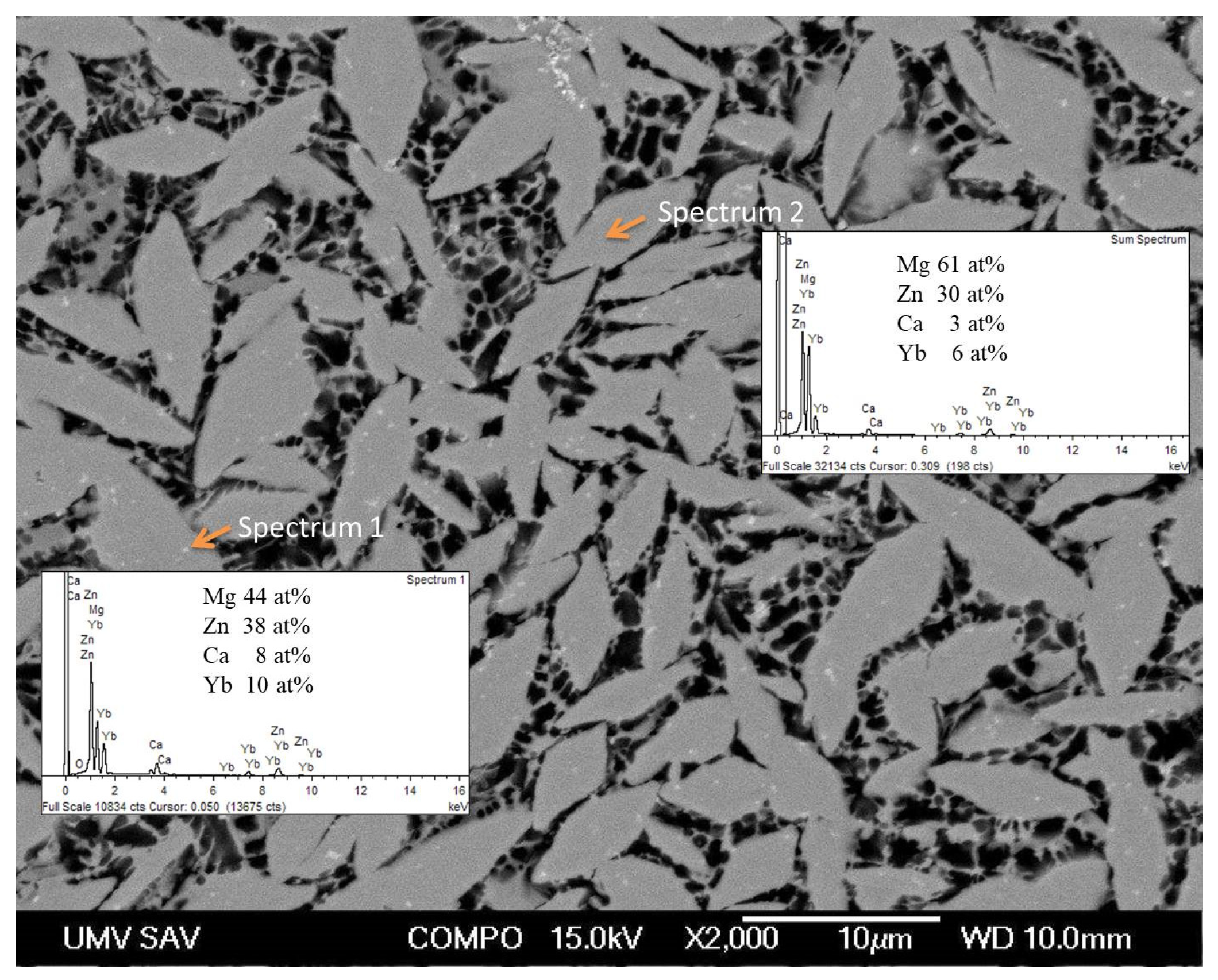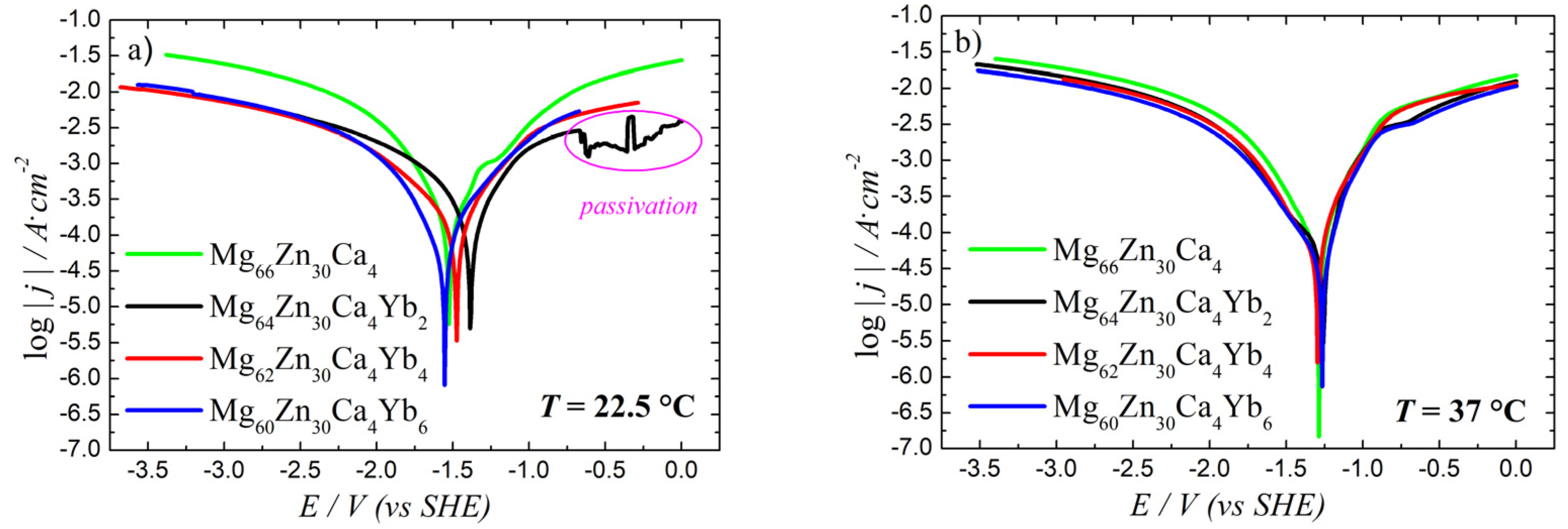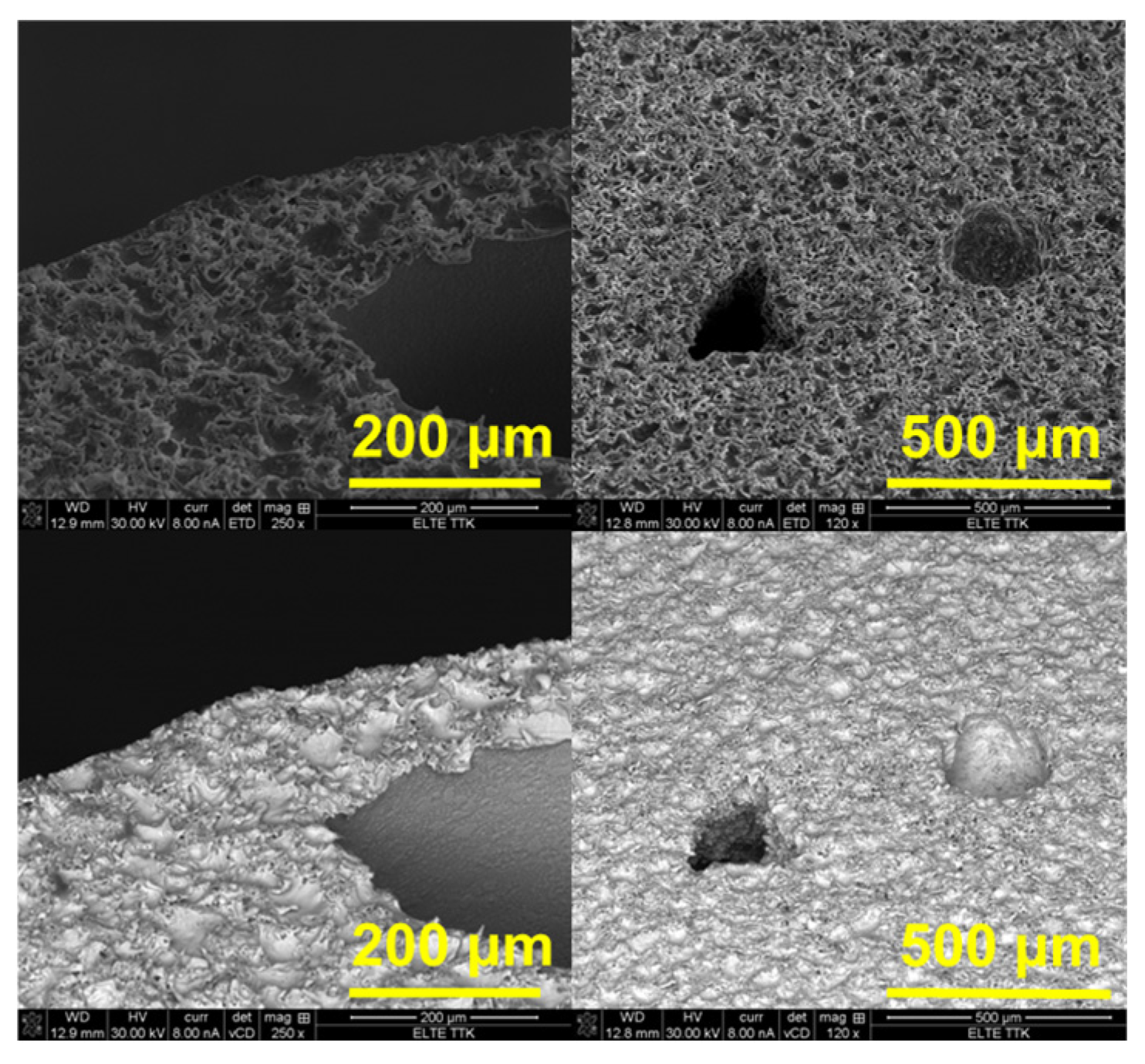Ytterbium-Modified Rapidly Solidified Mg-Zn-Ca Alloys: Improvements in Strength and Corrosion Resistance for Biodegradable Implant Applications
Highlights
- Yb addition (2–4 at.%) enhances amorphous formation in Mg66Zn30Ca4 alloys.
- Yb addition improved mechanical and electrochemical properties of Mg-Zn-Ca al-loys.
- Controlled Yb incorporation optimize structural integrity and biocompatibility in Mg–Zn–Ca–Yb systems.
- Yb modification enhances the suitability of Mg-Zn-Ca alloys for biodegradable or-thopedic implants.
Abstract
1. Introduction
- high yield strength (>300 MPa) and enhanced toughness,
- lower elastic modulus, closer to that of cortical bone, minimizing stress shielding,
- better corrosion resistance and improved biocompatibility.
2. Materials and Methods
2.1. Materials Preparation
2.2. Microstructure and Chemical Characterization
2.3. Mechanical Testing
2.4. Electrochemical Properties
3. Results and Discussion
3.1. Microstructure Characterization
3.2. Mechanical Properties
3.3. Electrochemical Characteristics
4. Conclusions
Author Contributions
Funding
Institutional Review Board Statement
Informed Consent Statement
Data Availability Statement
Conflicts of Interest
Abbreviations
| UCS | Ultimate compressive strength |
| EDS | Energy dispersive spectrometer |
| BMG | Bulk metallic glasses |
| EIT | Indentation elastic modulus |
| HIT | Indentation hardness |
| ρ | Density |
| Icorr | Corrosion current |
| jcorr | Corrosion current density |
| Rcorr | Polarization resistance |
| v | Corrosion rate |
| Ecorr | Corrosion potential |
References
- Staiger, M.P.; Pietak, A.M.; Huadmai, J.; Dias, G. Magnesium and Its Alloys as Orthopedic Biomaterials: A Review. Biomaterials 2006, 27, 1728–1734. [Google Scholar] [CrossRef]
- Chen, Q.; Thouas, G.A. Metallic Implant Biomaterials. Mater. Sci. Eng. R Rep. 2015, 87, 1–57. [Google Scholar] [CrossRef]
- Sadat Hashemi, T.; Jaiswal, S.; McCarthy, H.O.; Levingstone, T.J.; Dunne, N.J. Biofunctionalisation of Porous Additively Manufactured Magnesium-Based Alloys for Orthopaedic Applications: A Review. Biomater. Adv. 2025, 169, 214170. [Google Scholar] [CrossRef]
- Biesiekierski, A.; Wang, J.; Abdel-Hady Gepreel, M.; Wen, C. A New Look at Biomedical Ti-Based Shape Memory Alloys. Acta Biomater. 2012, 8, 1661–1669. [Google Scholar] [CrossRef] [PubMed]
- Bommala, V.K.; Krishna, M.G.; Rao, C.T. Magnesium Matrix Composites for Biomedical Applications: A Review. J. Magnes. Alloy. 2019, 7, 72–79. [Google Scholar] [CrossRef]
- Chen, J.; Tan, L.; Yu, X.; Etim, I.P.; Ibrahim, M.; Yang, K. Mechanical Properties of Magnesium Alloys for Medical Application: A Review. J. Mech. Behav. Biomed. Mater. 2018, 87, 68–79. [Google Scholar] [CrossRef]
- Banerjee, P.C.; Al-Saadi, S.; Choudhary, L.; Harandi, S.E.; Singh, R. Magnesium Implants: Prospects and Challenges. Materials 2019, 12, 136. [Google Scholar] [CrossRef] [PubMed]
- Thomas, K.K.; Zafar, M.N.; Pitt, W.G.; Husseini, G.A. Biodegradable Magnesium Alloys for Biomedical Implants: Properties, Challenges, and Surface Modifications with a Focus on Orthopedic Fixation Repair. Appl. Sci. 2024, 14, 10. [Google Scholar] [CrossRef]
- Kumar, G.; Karakulak, E.; Aikin, M.; Shalomeev, V.; Kukhar, V.; Kostryzhev, A.; Kuziev, I.; Kulynych, V.; Dykha, O.; Dytyniuk, V.; et al. Recent Advances in Biodegradable Magnesium Alloys for Medical Implants: Evolution, Innovations, and Clinical Translation. Crystals 2025, 15, 671. [Google Scholar] [CrossRef]
- Gulenko, A.; Forto Chungong, L.; Gao, J.; Todd, I.; Hannon, A.C.; Martin, R.A.; Christie, J.K. Atomic Structure of Mg-Based Metallic Glasses from Molecular Dynamics and Neutron Diffraction. Phys. Chem. Chem. Phys. 2017, 19, 8504–8515. [Google Scholar] [CrossRef]
- Kiani, F.; Wen, C.; Li, Y. Prospects and Strategies for Magnesium Alloys as Biodegradable Implants from Crystalline to Bulk Metallic Glasses and Composites—A Review. Acta Biomater. 2020, 103, 1–23. [Google Scholar] [CrossRef] [PubMed]
- Ramya, M.; Ravi, K.R. Biodegradable Nanocrystalline Mg-Zn-Ca-Ag Alloys as Suitable Materials for Orthopedic Implants. Mater. Today Proc. 2022, 58, 721–725. [Google Scholar] [CrossRef]
- Onyeagba, C.R.; Tesfamichael, T. A Review on Mg-Based Metallic Glasses for Biomedical Scaffolds: Experimental and Computational Modeling. Microstructures 2025, 5, 2025035. [Google Scholar] [CrossRef]
- Li, Z.; Huang, Z.; Sun, F.; Li, X.; Ma, J. Forming of Metallic Glasses: Mechanisms and Processes. Mater. Today Adv. 2020, 7, 100077. [Google Scholar] [CrossRef]
- Biały, M.; Hasiak, M.; Łaszcz, A. Review on Biocompatibility and Prospect Biomedical Applications of Novel Functional Metallic Glasses. J. Funct. Biomater. 2022, 13, 245. [Google Scholar] [CrossRef]
- Inoue, A.; Kato, A.; Masumoto, T.; Zhang, T.; Kim, S.G. Mg–Cu–Y Amorphous Alloys with High Mechanical Strengths Produced by a Metallic Mold Casting Method. Mater. Trans. JIM 1991, 32, 609–616. [Google Scholar] [CrossRef]
- Sezer, N.; Evis, Z.; Koç, M. Additive Manufacturing of Biodegradable Magnesium Implants and Scaffolds: Review of the Recent Advances and Research Trends. J. Magnes. Alloy. 2021, 9, 392–415. [Google Scholar] [CrossRef]
- Liang, Z.; Yang, L.; Yongyan, L.; Wang, X.; Qin, C.; Zhao, W.; Yu, H.; Wang, Z. Effects of Ag, Nd, and Yb on the Microstructures and Mechanical Properties of Mg–Zn–Ca Metallic Glasses. Metals 2018, 8, 856. [Google Scholar] [CrossRef]
- Zheng, Y.F.; Gu, X.N.; Witte, F. Biodegradable Metals. Mater. Sci. Eng. R Rep. 2014, 77, 1–34. [Google Scholar] [CrossRef]
- Cai, S.; Lei, T.; Li, N.; Feng, F. Effects of Zn on Microstructure, Mechanical Properties and Corrosion Behavior of Mg–Zn Alloys. Mater. Sci. Eng. C 2012, 32, 2570–2577. [Google Scholar] [CrossRef]
- Sharma, A.; Zadorozhnyy, V. Review of the Recent Development in Metallic Glass and Its Composites. Metals 2021, 11, 1933. [Google Scholar] [CrossRef]
- Yu, H.J.; Wang, J.Q.; Shi, X.T.; Louzguine-Luzgin, D.V.; Wu, H.K.; Perepezko, J.H. Ductile Biodegradable Mg-Based Metallic Glasses with Excellent Biocompatibility. Adv. Funct. Mater. 2013, 23, 4793–4800. [Google Scholar] [CrossRef]
- Saksl, K.; Pethes, I.; Jóvári, P.; Molčanová, Z.; Ďurišin, J.; Ballóková, B.; Temleitner, L.; Michalik, Š.; Šuliková, M.; Šuľová, K.; et al. Atomic Structure of the Mg66Zn30Ca4 Metallic Glass. J. Non. Cryst. Solids 2021, 558, 120660. [Google Scholar] [CrossRef]
- Oliver, W.C.; Pharr, G.M. An Improved Technique for Determining Hardness and Elastic Modulus Using Load and Displacement Sensing Indentation Experiments. J. Mater. Res. 1992, 7, 1564–1583. [Google Scholar] [CrossRef]
- Turnbull, G.; Clarke, J.; Picard, F.; Riches, P.; Jia, L.; Han, F.; Li, B.; Shu, W. 3D Bioactive Composite Scaffolds for Bone Tissue Engineering. Bioact. Mater. 2018, 3, 278–314. [Google Scholar] [CrossRef] [PubMed]
- Zysset, P.K.; Edward Guo, X.; Edward Hoffler, C.; Moore, K.E.; Goldstein, S.A. Elastic Modulus and Hardness of Cortical and Trabecular Bone Lamellae Measured by Nanoindentation in the Human Femur. J. Biomech. 1999, 32, 1005–1012. [Google Scholar] [CrossRef] [PubMed]
- Edward Hoffler, C.; Edward Guo, X.; Zysset, P.K.; Goldstein, S.A. An Application of Nanoindentation Technique to Measure Bone Tissue Lamellae Properties. J. Biomech. Eng. 2005, 127, 1046–1053. [Google Scholar] [CrossRef]
- ASTMG59-97; Standard Test Method for Conducting Potentiodynamic Polarization Resistance Measurements. ASTM: West Conshohocken, PA, USA, 2004.
- Pourbaix, M. Atlas of Electrochemical Equilibria in Aqueous Solutions; National Association of Corrosion Engineers: Houston, TX, USA, 1974. [Google Scholar]
- Lu, W.; He, M. Mg-Zn-Yb-Ag Amorphous Rods: A Novel Orthopedic Biodegradable Material with Good Mechanical Properties and Antibacterial Properties. J. Non. Cryst. Solids 2023, 602, 122090. [Google Scholar] [CrossRef]
- Lu, W.; He, M.; Yu, D.; Xie, X.; Wang, H.; Wang, S.; Yuan, C.; Chen, A. Ductile Behavior and Excellent Corrosion Resistance of Mg-Zn-Yb-Ag Metallic Glasses. Mater. Des. 2021, 210, 110027. [Google Scholar] [CrossRef]
- Li, L.; Wang, T.; Wang, Y.; Zhang, C.C.; Lv, H.; Lin, H.; Yu, W.-B.; Huang, C.J. Effects of Ytterbium Addition and Heat Treatment on the Mechanical Properties and Biocorrosion Behaviors of Mg–Zn–Zr Alloy. J. Magnes. Alloy. 2020, 8, 499–509. [Google Scholar] [CrossRef]
- Bai, X.; Li, L.; Xia, Y.; Xue, P.; Zhang, B.; Duan, Y.; Dan, W. Mechanical Properties and In-Vitro Degradation Behaviors of Mg–Yb Extrusion Alloys. J. Alloys Compd. 2025, 1039, 183158. [Google Scholar] [CrossRef]






| Sample | Mg | Zn | Ca | Yb |
|---|---|---|---|---|
| Mg64Zn30Ca4Yb2 | 63 | 31 | 4 | 2 |
| Mg62Zn30Ca4Yb4 | 62 | 30 | 4 | 4 |
| Mg60Zn30Ca4Yb6 | 59 | 31 | 4 | 6 |
| ρ (g·cm−3) | UCS (MPa) | HIT (GPa) | EIT (GPa) | |
|---|---|---|---|---|
| Mg64Zn30Ca4Yb2 | 3.177 ± 0.016 | 528 | 3.26 ± 0.165 | 71 |
| Mg62Zn30Ca4Yb4 | 3.22 ± 0.017 | 591 | 3.49 ± 0.028 | 70 |
| Mg60Zn30Ca4Yb6 | 3.46 ± 0.012 | 518 | 2.88 ± 0.321 | 72 |
| Ti6Al4V | 4.42 | 850 | 5.6 | 120 |
| Human Bones | 1.7–2.1 | 70–280 | 0.82 ± 0.092 | 17–30 |
| Results of the Tafel Analysis at 22.5 °C | |||||
|---|---|---|---|---|---|
| Alloys | Icorr (mA) | jcorr (µA∙cm−2) | Rcorr (Ω) | v (mm/y) | Ecorr (V) |
| Mg66Zn30Ca4 | 9.54 | 2004 | 27 | 41.3 | −1.24 |
| Mg64Zn30Ca4Yb2 | 4.03 | 915 | 77 | 18.9 | −1.16 |
| Mg62Zn30Ca4Yb4 | 1.07 | 362 | 82 | 7.9 | −1.34 |
| Mg60Zn30Ca4Yb6 | 1.01 | 234 | 83 | 5.22 | −1.37 |
| Results of the Tafel Analysis at 37 °C | |||||
| Alloys | Icorr (mA) | jcorr (µA∙cm−2) | Rcorr (Ω) | v (mm/y) | Ecorr (V) |
| Mg66Zn30Ca4 | 2.32 | 494 | 57 | 10.0 | −1.11 |
| Mg64Zn30Ca4Yb2 | 1.55 | 329 | 72.9 | 6.8 | −1.07 |
| Mg62Zn30Ca4Yb4 | 1.44 | 306 | 79.7 | 6.73 | −1.17 |
| Mg60Zn30Ca4Yb6 | 1.28 | 273 | 94.8 | 6.1 | −1.14 |
Disclaimer/Publisher’s Note: The statements, opinions and data contained in all publications are solely those of the individual author(s) and contributor(s) and not of MDPI and/or the editor(s). MDPI and/or the editor(s) disclaim responsibility for any injury to people or property resulting from any ideas, methods, instructions or products referred to in the content. |
© 2025 by the authors. Licensee MDPI, Basel, Switzerland. This article is an open access article distributed under the terms and conditions of the Creative Commons Attribution (CC BY) license (https://creativecommons.org/licenses/by/4.0/).
Share and Cite
Molčanová, Z.; Ballóková, B.; Saksl, K.; Džupon, M.; Zalka, D.; Dankházi, Z. Ytterbium-Modified Rapidly Solidified Mg-Zn-Ca Alloys: Improvements in Strength and Corrosion Resistance for Biodegradable Implant Applications. Materials 2025, 18, 4959. https://doi.org/10.3390/ma18214959
Molčanová Z, Ballóková B, Saksl K, Džupon M, Zalka D, Dankházi Z. Ytterbium-Modified Rapidly Solidified Mg-Zn-Ca Alloys: Improvements in Strength and Corrosion Resistance for Biodegradable Implant Applications. Materials. 2025; 18(21):4959. https://doi.org/10.3390/ma18214959
Chicago/Turabian StyleMolčanová, Zuzana, Beáta Ballóková, Karel Saksl, Miroslav Džupon, Dóra Zalka, and Zoltán Dankházi. 2025. "Ytterbium-Modified Rapidly Solidified Mg-Zn-Ca Alloys: Improvements in Strength and Corrosion Resistance for Biodegradable Implant Applications" Materials 18, no. 21: 4959. https://doi.org/10.3390/ma18214959
APA StyleMolčanová, Z., Ballóková, B., Saksl, K., Džupon, M., Zalka, D., & Dankházi, Z. (2025). Ytterbium-Modified Rapidly Solidified Mg-Zn-Ca Alloys: Improvements in Strength and Corrosion Resistance for Biodegradable Implant Applications. Materials, 18(21), 4959. https://doi.org/10.3390/ma18214959






